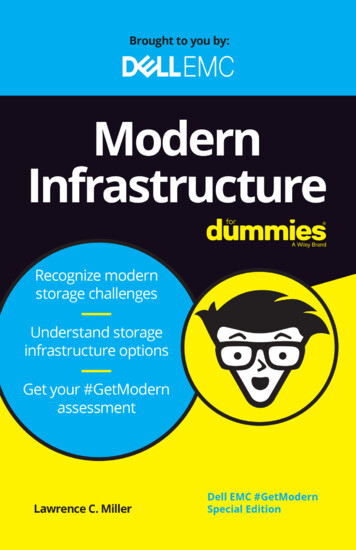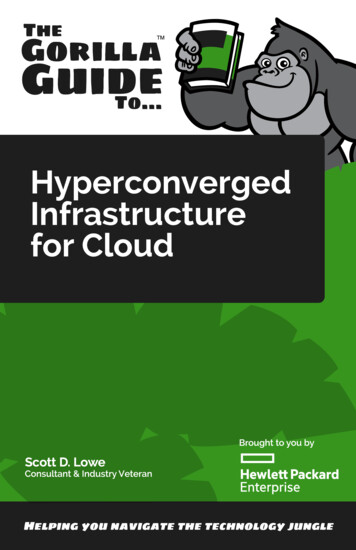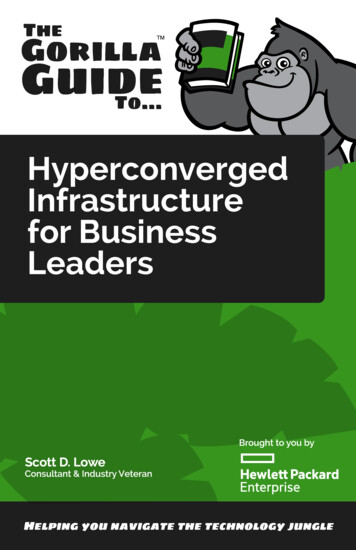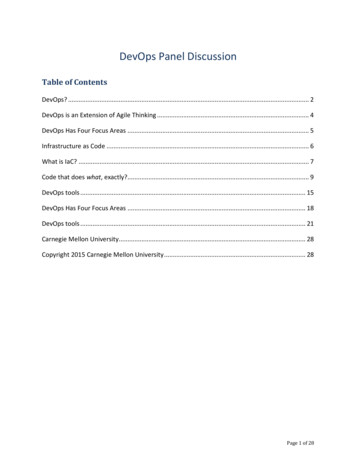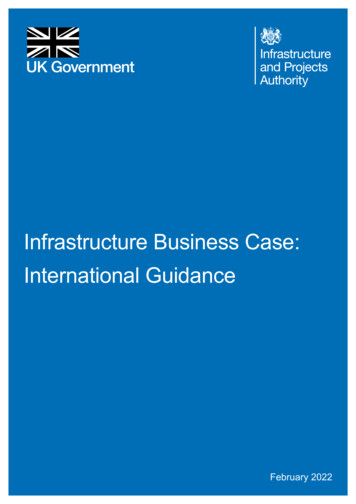
Transcription
Infrastructure Business Case:International GuidanceFebruary 2022
This second edition replaces the original July 2020 edition and includes best practice materialson decarbonisation, climate change, and green finance. Crown copyright 2022Produced by the Infrastructure and Projects AuthorityYou may re-use this information (excluding logos) free of charge in any format or medium,under the terms of the Open Government Licence. To view this licence, overnment-licence/or email: psi@nationalarchives.gsi.gov.ukWhere we have identified any third party copyright material you will need to obtain permissionfrom the copyright holders concerned.Any enquiries regarding this publication may be sent to us by e mail at IPA@ipa.gov.uk
ContentsPurpose of this Guidance 21.2The role of infrastructure 21.3The importance of the infrastructure project business case 31.4The Five Case Model (5CM) 31.5Policies, Portfolios, Programmes, and Projects 51.6How to use this Guidance 61.7Guidance structure 71.8Audience for this Guidance 71.9Training 81.10Acknowledgements 8112.1Overview of the 5CM methodology 122.2The business case development process 132.3Assurance and Approval framework for 5CM Business Cases 19233.1Complementary tools and methodologies 243.2Sustainable infrastructure and economic development 273.3Sustainable Development Goals (SDGs) and infrastructure projects 283.4Sustainable finance 3004. Detailed guidance 4.1335CM Business Case Actions 34Early Business Case 38Strategic Case 391. Describe the project, its strategic context and strategic aims 40ESG focus 1 – Inclusive growth and infrastructure 432. Determine objectives, outputs, existing arrangements and needs. 443. Define potential scope 48ESG Focus 2 – Infrastructure planning for climate change resilience and adaptation 494. Describe project benefits, risks, opportunities, constraints and dependencies 50Infrastructure Business Case: International Guidance iiiInfrastructure Projects03. Infrastructure Projects – broader context Detailed guidance02. The Five Case Model The Five Case Model1.1Introduction01. Introduction 1
4.2Economic Case 585. Define critical success factors 59ESG Focus 3 – Climate and decarbonisation in the Economic Case 616. Apply ‘Options Framework’ 637. Scope environmental (including climate change and carbon) and social impactassessment, technical and other studies 76Commercial Case 818. Consider contractual arrangements 819. Consider bidder market and procurement options 85Financial Case 9210. Estimate costs, affordability and ability to raise finance 92Management Case 9711. Identify project delivery, management and governance structure 9712. Develop an initial project plan and assurance and approvals plan 10113. Identify stakeholders, stakeholder engagement and change management 10314. Develop an initial benefits realisation plan 10615. Draft initial risk management strategy and plan 108Transition Point 11116. Commission environmental and social impact assessment (ESIA), technical andother studies 113Intermediate Business Case 114Strategic Case 11417. Reconsider the Strategic Case and reconfirm the Strategic Need 114Economic Case 11618. Prepare the economic analysis for the options identified 116Accuracy of estimations 12619. Undertake qualitative benefits and risks analysis 12920. Select preferred option and undertake sensitivity analysis 13021. Review Environmental (including climate change and carbon) and Social ImpactAssessment, technical and other studies 132Commercial Case 13622. Develop the commercial approach for the preferred option; allocate risk 13623. Draft project specification and Heads of Terms 14024. Undertake market engagement 14425. Develop ‘Procurement Plan’ and engage with multilateral development banks (ifapplicable) 145iv Infrastructure Business Case: International Guidance
4.3Financial Case 15026. Confirming funding sources 15127. Build financial model 15228. Test affordability 155Management Case 15829. Finalise delivery, management and governance structure 15830. Draft section on use of advisers 16031. Develop project plan and assurance and approvals plan 16132. Finalise project delivery budget 16333. Finalise and implement stakeholder engagement plan 16434. Finalise change management strategy and plan 16635. Finalise benefits realisation plan and risk management strategy and plan 16936. Draft project evaluation plan 172Transition Point 17537. Draft procurement documents and evaluation criteria 17738. Run procurement process and undertake bid evaluation 178Full Business Case 17939. Update Strategic Case if necessary 17940. Reconsider Economic Case options based on cost data received from bidders 18041. Select preferred bidder 18142. Document the procurement process and the contract outcomes 18243. Confirm the affordability of the prospective preferred bidder’s final offer 18444. Review and update all sections of IBC Management Case 185Transition Point 18745. Sign contracts with preferred bidder 187Schedule – 1 Glossary 190Schedule – 2 Workshops 201Schedule – 3 Working with multilateral development banks 230Schedule – 4 Sustainability and inclusive growth frameworks 242Schedule – 5 G20 Principles 248Schedule – 6 H igh-level explanation of the Project Development Routemap and BuildingInformation Modelling 254Schedule – 7 Summary of actions required for each Business Case 261Schedule – 8 Bibliography 268Schedule – 9 Environmental and social impact assessment review checklist 272Schedule – 10 Sustainable finance and the Five Case Model 276Infrastructure Business Case: International Guidance vSchedules05. Schedules 189
There are Annexes to this Guidance in separate companion documents which contain:o A tailored Case Study (standalone document)o Templates for:– A – Scoping and Assurance and Approval Document– B – Early Business Case (EBC Template)– C – Intermediate Business Case (IBC Template)– D – Full Business Case (FBC Template)– E – Single Stage Business Case – Low Value– F – Single Stage Business Case – Medium Value– Appendix I: Workshop – Strategic Needs– Appendix II: Workshop – Options Development– Appendix III: Workshop – Project Level Carbono Training materials (background and links)Diagram ReferencesDiagram 1 – The Delivery Pyramid 6Diagram 2 – Stages of a project’s business case development 16Diagram 3 – L evel of completion of Early, Intermediate and Full Business Cases 17Diagram 4 – The importance of early stage thinking 18Diagram 5 – UK Assurance and Approval process 22Diagram 6 – Sustainable Development Goals relationship to project outcomes 29Diagram 7 – Business Case Development Flowchart 35Diagram 8 – The Options Framework filter 64Diagram 9 – Procurement value chain for infrastructure projects 89Diagram 10 – Typical governance and delivery structure 98Diagram 11 – T he relationship between optimism bias and risk through stages ofproject development 124Diagram 12 – Net Present Value (NPV) of the Public Sector Comparator (PSC) vsPublic-Private Partnership (PPP) 127Diagram 13 – Indicative negotiated process 147Diagram 14 – The five workshops against the five cases 201Diagram 15 – Sustainable Development Goals 243Diagram 16 – Project Development Routemap 256Diagram 17 – Building Information Modelling 260vi Infrastructure Business Case: International Guidance
Table ReferencesTable 1 – High-level strategic risks 53Table 2 – Summary table of Strategic Case in the Early Business Case 56Table 3 – Developing critical success factors 59Table 4 – Options Framework analysis of the ‘Business as Usual’ option 63Table 5 – The Options Framework for developing a list of options 65Table 6 – Applying the Options Framework for Scope 66Table 7 – Using the Options Framework for Scope 66Table 8 – Laying out the matrix of options 67Table 9 – Matrix of options 69Table 10 – Preferred approach option 70Table 11 – More ambitious option 71Table 12 – Less ambitious option 72Table 13 – Matrix of options following analysis 73Table 14 – Strengths, Weaknesses, Opportunities and Threats 74Table 15 – IFC Environmental and Social Categorisation 78Table 16 – Summary table of the Economic Case in the Early Business Case 80Table 17 – Analysing procurement options 87Table 18 – Simple and complex procurement processes 88Table 19 – Summary table of the Commercial Case in the Early Business Case 91Table 20 – Issues raised in market sounding 95Table 21 – Summary table of Financial Case in the Early Business Case 96Table 22 – Identifying function and cost of advisers 100Table 23 – Stakeholder engagement matrix 105Table 24 – Initial benefits realisation plan 107Table 25 – Initial risk management 109Table 26 – Summary table of the Management Case in the Early Business Case 110Table 27 – Business Case change log 115Table 28 – Summary table of the Strategic Case in the Intermediate Business Case 115Table 29 – Economic vs Financial Appraisals 118Table 30 – Discounting Values 119Table 31 – Categorising benefits 120Table 32 – Categorising costs 122Table 33 – Calculating Public Value 125Table 34 – Comparing Public Value with the Benefits-Cost Ratio 125Table 35 – PPP delivery suitability 128Table 36 – Summary of overall results 129Table 37 – Summary table of options sensitivity analysis 131Table 38 – Summary table of the Economic Case in the Intermediate Business Case 135Infrastructure Business Case: International Guidance vii
Table 39 – Risk allocation for PPP project 137Table 40 – Summary table of the Commercial Case in the Intermediate Business Case 149Table 41 – Contrasting the Economic Case with the Financial Case 151Table 42 – Summary of Financial Appraisal 156Table 43 – Summary table of the Financial Case in the Intermediate Business Case 157Table 44 – Contractual arrangements with advisers 160Table 45 – Change Management Plan 168Table 46 – Risk register 171Table 47 – Summary table of the Management Case in the Intermediate Business Case 173Table 48 – Summary table of the Strategic Case in the Full Business Case 180Table 49 – Summary table of the Economic Case in the Full Business Case 182Table 50 – Summary of the Commercial Case in the Full Business Case 183Table 51 – Summary table of the Financial Case in the Full Business Case 185Table 52 – Summary of the Management Case in the Full Business Case 186Table 53 – Project roles and descriptions 198Table 54 – Risk allocation example 221Table 55 – List of MDBs 230Table 56 – World Bank Group’s five institutions 231Table 57 – Significant ESG frameworks 278viii Infrastructure Business Case: International Guidance
01Introduction
Introduction1.101Purpose of this GuidanceThis Guidance offers a proven methodology and framework for thinkingabout the development, approval, procurement, and delivery ofinfrastructure project proposals.It will give confidence to those tasked to produce business cases, as well as to those whoapprove them, and those who want to invest in them, that projects are well researched,evidenced-based, and are good investment opportunities. It will provide a safeguard toministers and officials that a project is properly considered from all angles and will reducethe risk of unexpected problems delaying and disrupting the progress of the project as itis prepared for the market.It is suitable for all types of infrastructure projects, whether economic (such as transportor telecommunications), environmental (such as power or waste management), or social(such as education, health or housing); and can be applied proportionately to smallersub‑national projects as well as to bigger national projects.It can be used by any country around the world irrespective of its legal or governmentalsystem (civil or common law). This is because the questions that a properly developedproject proposal asks are the same the world over – though the solutions it drives out maybe different. It is hoped that countries embarking on the development of infrastructurewill find this to be a valuable tool, and may wish to adopt the model, or adapt their ownversions of this Guidance, as a matter of public policy.1.2 The role of infrastructureInfrastructure is essential to the prosperity and wellbeing of a country and its citizens.Transport links enable travel and movement of goods, energy systems power homesand businesses, and digital connections allow communications. Infrastructure suppliesclean water, manages waste, and provides shelter. Yet, in many places, there is a gapbetween the quality or condition of existing infrastructure and the standard needed toenable people to lead secure lives, with poor and marginalised communities particularlyaffected. Governments need robust information, advice, and direction to invest wisely onbehalf of their people and countries. Financiers want to invest in infrastructure but find itdifficult to commit effort and funds without clear and robust proposals.Planning and delivering strategically important, high quality and investable infrastructureprojects requires clear, proportionate and well-structured business cases.2 Infrastructure Business Case: International Guidance
Every infrastructure project should have a ‘business case’ or proposal to explain why itis needed and how it can be taken forward. This guidance provides a methodology – the‘Five Case Model’ – to achieve this, and to help governments develop, approve and presentprojects successfully to the market.The business case is a strategic tool for scoping, planning, and implementing projects,and an aid to effective decision-making. The Five Case Model (5CM) provides a frameworkfor developing standardised and comprehensive business cases.The purpose of business cases is defined by the UK’s Treasury as:“a management tool developed over time as a living document as the project develops.[It] keeps together and summarises the results of all the necessary research and analysisneeded to support decision-making in a transparent way.”Projects will only achieve their objectives and deliver benefits to society if they have beenrobustly scoped and realistically planned from the outset, and if the associated risks areidentified and managed appropriately. The business case provides a framework for this,set around three basic questions:o where are we now?o where do we want to get to?o how are we going to get there?It also provides:o a structured format to allow an organisation to develop standardised proposals andexplain and justify any particular project or programme;o a tool to enable an approving body to decide whether or not to allow a project orprogramme to go forward;o an overall process for the scoping and planning of government investments; ando an evidence-based audit trail to assist transparent decision-making.This framework helps develop the business case over the life of the project. It provides arecord of the project development process. In its final form, it becomes the key documentof record for the proposal.1.4 The Five Case Model (5CM)The 5CM is used to develop business cases using a framework of five dimensions, andprovides decision-makers and stakeholders with a process for structured thinking andplanning, giving confidence that the project:Infrastructure Business Case: International Guidance 3Introduction1.3 The importance of the infrastructure projectbusiness case
o Provides a strategic fit in the broad context of the national and local infrastructuresystems, and is aligned with high-level strategic aims. This dimension confirms thestrategic need for the investment and resulting services. This is the ‘strategic case’section of the project business case.o Will maximise public value to society through the selection of the optimalcombination of components, products and related activities. This dimension focuseson options appraisal and the identification of the preferred option. This is the‘economic case’ section of the project business case.o Is commercially viable and attractive to the supply side and can be practicallydelivered by the market. This dimension focuses on the development andprocurement of the potential ‘Deal’. This is the ‘commercial case’ section of theproject business case.o Is affordable and is fundable over time. This dimension focuses on the wholelife costs of the proposed deal. This is the ‘financial case’ section of the projectbusiness case.o Can be delivered successfully by the organisation and its partners, and that therequired resources, capacity and capability for managing and delivering the projectare in place or can be developed. This dimension focuses on the implementationarrangements for the proposal. This is the ‘management case’ section of the projectbusiness case.The 5CM methodology is gaining worldwide recognition as it:o reflects the ‘G20 Principles for the Infrastructure Project Preparation Phase’ (the ‘G20Principles’); these require infrastructure business cases to be written and assessedagainst: project rationale, options appraisal, commercial viability, long-termaffordability and deliverability;1o supports the G20’s recognition of the importance of “Inclusive and InterconnectedDevelopment” in advancing sustainable development goals;2o supports the G20 Principles for Quality Infrastructure Investment (QII), by addressingthe six principles throughout the development of the business case, and focussing onsustainability and maximising the positive impacts of infrastructure investment3 (seeSchedule 5 for more on G20 QII Principles);o supports the United Nations Sustainable Development Goals, in particular:social sustainability: good infrastructure design, planning and delivery contributesto inclusive economic growth, supporting essential service delivery, increasingproductivity and enabling citizens to access better jobs and more profitablemarkets; and1G20 Finance Ministers and Central Bank Governors endorsed these key principles at the Buenos Aires summit, July 2018. MDBs havealso endorsed these principles, for further details see Schedule 5 – G20 Principles.2As agreed at the G20 Hangzhou summit in 2016 and the 2018 G20 Buenos Aries Summit’s ‘G20 Leaders’ declaration on buildingconsensus for fair and sustainable cy/international policy/convention/g20/annex6 1.pdf4 Infrastructure Business Case: International Guidance
A Spanish version of the Guidance, specially adapted for use in Colombia, is available4 anda Bahasa Indonesia version, adapted with supplementary material for use in Indonesia, isalso available.51.5 Policies, Portfolios, Programmes, and ProjectsThe business case approach can be used to plan all levels of infrastructure developmentas described below, although this Guidance is specifically designed for project levelbusiness cases:o Policies – for the long-term development of infrastructure. The 5CM, especially theOptions Framework6, offers a tool to support policy and strategy development.o Portfolios – for the strategic planning of programmes and projects.o Programmes – for the delivery of inter-related projects. Programme business casesoutline the overall strategy and budget for a group of inter-related projects.o Projects – to deliver the outputs and investments required to meet strategic aims andimplement policies.The ‘Delivery Pyramid’ below shows the hierarchy of Policy, Portfolios, Programmes, andProjects. At the lowest level, individual projects need to demonstrate how they alignto wider strategic aims. Projects and programmes are the mechanisms for deliveringthe higher-level strategies. Programmes then fit within a departmental portfolio, andportfolios are designed to deliver the strategic policy objectives of a departmentalor national plan. The plans should be created from top to bottom to ensure overallconsistency and fit. Building from bottom to top risks compiling unrelated projects into amismatched programme. Where there is a series of related projects, a programme planshould therefore be created before the individual project business s-app.aspx5For Bahasa Indonesian translations please contact the IPA (International Team).6Described in the Detailed Guidance (Early Business Case – Economic Case).Infrastructure Business Case: International Guidance 5Introductionenvironmental sustainability: with rapid environmental change, decision-makersmust ensure infrastructure is both resilient to climate change and naturaldisasters, and accounts for the minimisation and adaptation of environmentaland climate impacts by utilising best practices, latest technologies andsustainable materials.
Diagram 1 – The Delivery PyramidLevelProductWhoPolicyManifesto orNational nistry/DepartmentProgrammesProgrammeBusiness CaseProgrammeTeamProjectsProjectBusiness CaseProjectTeamDelivery Pyramid1.6 How to use this GuidanceThis Guidance sets out the process for developing the business case for infrastructureprojects in three stages:o The Early Business Case (EBC) is the scoping stage of the process;o The Intermediate Business Case (IBC) is the planning stage of the process leading toprocurement; ando The Full Business Case (FBC) is the delivery stage of the process where theprocurement leads to contracting.There are assurance points throughout the process, approval points at the end ofeach stage, and the business case is continuously revisited and updated throughoutthe process to ensure the data and analysis remains valid and accurate. This is furtherexpanded in Chapter 2 on the detailed 5CM methodology.This guidance should be used to:o understand the process for developing a business case;o understand the use of the Five Case Model as the methodology for developinginfrastructure project business cases;o understand how to plan the project assurance and approval process;o refer to the specified actions (as outlined in the detailed guidance chapter, andbusiness case development process-chart);o use the templates included in the annexes (adapted as appropriate);o identify appropriate stakeholders to contribute to the thinking and analysis;6 Infrastructure Business Case: International Guidance
o scope the various technical studies and analysis required;o understand treatment of financial and non-financial data; ando identify the skills and resources required to develop the business case, and thesupporting governance framework including defining roles and responsibilities.1.7 Guidance structureThe Guidance is structured as follows:o Introduction – describes the context of the Infrastructure Business Case;o Overview of the Five Case Model – describes the methodology for developing businesscases, and the associated assurance and approval framework;o Infrastructure Projects Business Case – broader context – provides an overview of arange of considerations relevant to the development of infrastructure proposals, withparticular focus on environmental, social, and governance (ESG) factors;o Detailed Guidance – which consists of step-by-step actions and instructions fordeveloping a business case, and applying assurance and approvals processes;o A series of development workshops for key stakeholders to help build the case;o A Case Study – which is a best practice example business case for a transport project,which complements the guidance;o Templates – which are provided to support business case development throughevery stage; ando A Glossary is provided at Schedule 1.1.8 Audience for this GuidanceCountries adopting the 5CM methodology can be confident they are applying bestpractice in line with the expectations of the international community, including theMultilateral Development Banks.The Guidance chapters are arranged to provide relevant information to differentstakeholders:o Elected representatives, senior managers, and policy makers – will be interested inChapters 1 and 2, which provide a high-level overview of the importance of businesscases, the 5CM methodology, and the strategic context of infrastructure projects.They will also find Chapter 3 helpful for understanding the potential for the 5CMto address sustainability and climate issues, and how project business cases mayincrease access to climate finance for developing infrastructure.Infrastructure Business Case: International Guidance 7Introductiono plan and host workshops to gather and test information as the business caseis developed;
o Practitioners and officials – responsible for scoping, planning and implementingprojects, as well as those responsible for assurance and approval functions, will beinterested in the full document. The Detailed Guidance in Chapter 4 can be usedthroughout the business case development process, along with the complimentarytools referenced, and the accompanying annexes and Case Study along withtemplates and supporting materials.Who should use this Guidance?Why?Officials and civil servants, programmeand project practitioners in central andlocal government ministries and agenciesIn order to write a business case for aproject, or to understand why or how aproject is being undertaken.To ensure that national environmental,social and governance (ESG) policies arereflected in infrastructure planning.Private sector advisers and practitionersIn order to support the development ofpublic sector infrastructure businesscases, and to ensure ESG policies areincorporated.Elected representativesIn order to understand why any project isbeing done, or should be done, and to helpmake an approval decision.Auditors, assurance, and approvalagenciesTo understand and facilitate review,assurance, and approval processes, or toaudit a project.Financial institutionsTo inform their credit assessment andinvestment decisions, and to see howtheir procurement and sustainabilitycriteria have been implemented.1.9 TrainingDetails of accredited training courses on this infrastructure guidance are available on thefollowing link:https://apmg-international.com/1.10 AcknowledgementsThis International Guidance on the development of Business Cases for InfrastructureProjects has been produced by the Infrastructure and Projects Authority (IPA).7 It is basedon the UK and International Business Case guidance produced by the UK tions/infrastructure-and-projects-authority8 Infrastructure Business Case: International Guidance
o the United Kingdom’s Foreign Commonwealth and Development Office, andEnvironment Agency;o the governments of Brazil, Colombia, Indonesia, Mexico, Peru, Brazil, South Africa,Vietnam, the Cayman Islands and the States of Guernsey;8o the World Bank; ando the HM Treasury and Welsh Government-sponsored Better Business Case StandardsBoard, with special thanks to Joe Flanagan,who have provided source materials and invaluable assistance in the development of thisGuidance and its adaptation for international use.HM Treasury, Green Book: nt8Infrastructure Business Case: International Guidance 9IntroductionThe IPA wishes to thank:
10 Infrastructure Business Case: International Guidance
02The Five CaseModel
The Five Case Model 02This methodology is based on best practice developed and used for manyyears in the United Kingdom, where it is known as ‘the Five Case Model’(5CM). It is part of a family of ‘Better Business Case’ guidance that maybe found on GOV.UK, the UK government’s website9. The methodologyis mandatory in the UK for the development of every type of majorgovernment policy, programme and project, whether infrastructure ornot. There is programme and project level guidance for the UK, as well asinternational versions.10This Guidance document, however, is designed specifically for infrastructure projects andfor international use. As countries recover from the global pandemic, there is a growingconsensus around the need for investment in sustainable and resilient infrastructure.11This updated edition of the Guidance responds to this need through an increased focus onenvironmental and social factors, including decarbonisation, climate change resilience,and green finance.2.1 Overview of the 5CM methodologyBusiness cases developed using the 5CM methodology look at a project from five keydimensions: Strategic, Economic, Commercial, Financial and Management. Each of theseinterrelated dimensions provide a ‘Case’.o The Strategic Case describes why the project is necessary. It provides therationale for the project, and the strategic fit with wider policy and strategies,and aligns the project with national infrastructure plans and national and localinfrastructure systems.It sets the project’s scope and boundaries, and describes clear project objectives andthe outputs required to deliver those objectives.The Strategic Case considers environmental and social risks and opportunitiesand the project’s alignment with national and global goals, including commitmentsunder the Paris Agreement on Climate Change and the 2030 UN Agenda forSustainable Development.HM Treasury, Green Book: nt10HM Treasury, Green Book, International Guidance: en-book-internationalguidance11See for example the UK Government’s ‘Ten Point Plan for a Green Industrial Revolution’. -point-plan-for-a-green-industrial-revolution912 Infrastructure Business Case: International Guidance
o The Economic Case determines how the project will deliver the economic, social, andenvironmental objectives, while achieving the most value for money for society, or‘public value’, from the investment.With a PPP (public-private partnership) project, the Eco
Infrastructure Business Case: International Guidance iii Commercial Case 159 42. Document the procurement process and the contract outcomes 159 Financial Case 161 . A TAILORED CASE STUDY (stand-alone document) TEMPLAT



